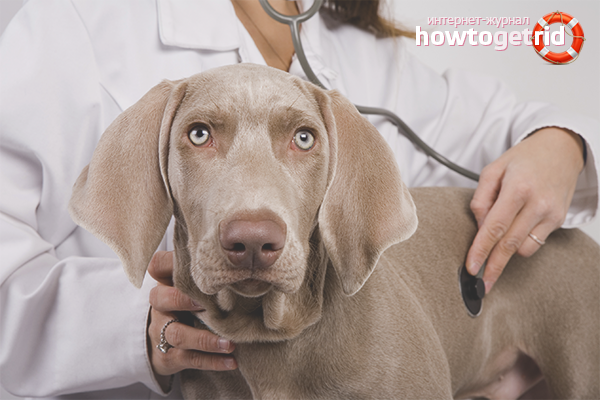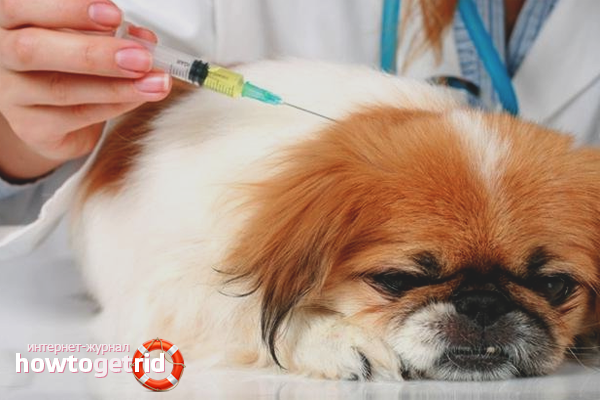The content of the article
The plague of carnivores is rightfully considered the most serious viral disease. It affects all organs and systems of the animal, as a result of which the disease is often fatal. The virus is transmitted through the contact of a healthy dog with a patient, most often unvaccinated pets are susceptible to plague. However, no matter how terrible the disease is, it can be eliminated in the early stages. The main thing is to identify the symptoms in time and start treatment immediately. Consider the important aspects in order.
Symptoms of plague in dogs
- As mentioned earlier, the plague of carnivores is a serious disease with a floating incubation period. The disease goes unnoticed during the first 5 days and can last up to 3 weeks.The animal looks quite healthy, although it is already a carrier.
- Viral infection appears gradually. First, the pet begins to tire quickly, he develops apathy, sadness, loss of appetite and craving for water. These symptoms characterize the first stage of the disease, it can be treated in 90% of cases, if symptoms are detected in time.
- In cases where the owner is so busy that he missed the depressed state of the dog, the plague continues to develop further. The transition to the second stage is caused by fever, conjunctivitis (discharge of pus from the eyes), diarrhea and vomiting. The dog lays a nose, a yellowish liquid flows out of the sinuses.
- Wool looks unkempt, shine is lost, hairs fall out and no longer grow. The animal refuses to eat, but leans on the water. Experienced fear of the light, so clogged in a dark corner. After a certain time, paralysis of the limbs develops, the airways overlap, the heart does not cope. As a result, death occurs.
Features of the plague of carnivores
The distemper may have a different dislocation shape, it affects the skin, nervous, pulmonary and intestinal zones. It is worth noting that each species does not appear separately, all areas are affected together.
The duration of the disease and the stages of its development depend on a number of factors.
- If the disease develops unnoticed, clinical signs may be absent altogether. The dog will die after 1-2 days. The super-acute form is manifested in the complete rejection of food, an increase in body temperature to a rate of 39 degrees. There comes a coma and the animal dies within 3 days.
- In 20% of cases, the plague can be cured in an acute form. All of these symptoms are eliminated, but the dog’s body will not be able to function properly. The animal partially loses hearing and sight, smell, mental disorders and nervous ticking begin.
- Plague can turn into a chronic disease that will last for months. The animal gradually "fades away", the symptoms periodically appear, and then disappear. In the end, the delayed course of the disease is fatal.
- The disease does not spare any of the specific systems of the animal.The dog strongly pulls limbs, it often has seizures, affects the brain, heart, liver.
Is plague transmitted from dog to dog
If one or several dogs live in the house, the question becomes: “Is the plague transmitted from one animal to another?”. The answer is one - yes, it is transmitted.
As mentioned earlier, distemper refers to a viral infection spreading through airborne droplets. That is, it is enough for one pet to lick or breathe on its fellow as the latter will be infected (if it is not vaccinated).
Important!
If a healthy pet has close contact with an infected person, it is already infected. By contact is meant feeding from a common bowl, playing, sleeping, studying stool.
The owner himself can bring the plague into the apartment and infect the animal. The virus is on top of clothes and shoes, flies through a window with dust particles. As a rule, infection occurs through the ears, nose and mouth. Once in the body, the pathogen infects the tissues, muscles, blood of the dog.
Is plague transmitted from dog to man
It is important to remember forever that a dog with a distemper needs the help of a host.You can safely proceed to treatment, the virus is not transmitted to a person.
Since the plague of carnivores is resistant to the external environment, it is necessary to closely monitor the hygiene of the apartment. If there is an unvaccinated pet in the house, treat floors and shoes with antiseptic disinfectants.
Treatment of plague in dogs
- Favorable outcome depends on the speed of the reaction of the host to the symptoms and their elimination. The sooner you start treatment, the greater the chances for the dog to recover. The most dangerous is the defeat of the nervous system. In this case, you can not do without the help of a veterinarian who will develop a therapy taking into account all the complications.
- Etiotropic therapy affects the plague pathogen itself. The serum is made with the use of antibodies of dogs that have previously been ill with plague. Of all the anti-plague drugs on the market, the most effective are the drugs of Narvak and Biocenter. The products presented have foreign analogs - “Biovet” and “Merial”.
- If we talk about the dose, then dogs up to 5 kg. 2 ml is administered. serum. In the case of larger pets - 5 ml.The drug is given once. If the symptoms do not disappear, repeat the action after 24 hours, observing the dosage. The use of drugs will give a good result only in the first stage of the disease.
- During the course of the distemper, the dog’s immune system suffers greatly. In order for the body's functions to remain at the proper level, the animal needs to be given immunostimulants. They contain interferon, which suppresses the vital activity of the virus.
- Also, the pet must be pierced with a solution of calcium and vitamin B. You can purchase the appropriate drugs in a veterinary or human pharmacy. The instruction is attached, but it is better to consult a doctor.
- In most cases, from the second stage of the plague in a dog, an increase in body temperature is observed. In this case, you should regularly monitor the indicators and give antipyretics to your pet.
- As mentioned earlier, the plague affects the respiratory tract of the dog. The animal strongly coughs, experiencing difficulties with access of oxygen. In this case, help your pet to remove phlegm from the lungs and bronchi in a medicamental way. Give him "Bromhexin" or "Mukaltin", the dose prescribed by the vet.
- In a dog with a distemper, purulent discharge from the eyes is noticed. Regularly rinse them with strong tea brew, insist it for at least half an hour. Get special eye drops for animals at a vet pharmacy.
Folk remedies for the plague
Many people prefer to treat the distemper by folk methods, they are no less effective. The complex is used in combination with antibiotics.
- Egg and honey. Mix in a homogeneous mass 1 chicken egg (raw), pour in 20 gr. liquid honey, beat the composition with a fork. Type the composition in a syringe, after removing the needle. Open the mouth of the animal, pour the mixture on the root of the tongue so that the animal does not spit it out. The course is 2-3 days, it all depends on the speed of the disappearance of symptoms and the immune system of the dog. The infusion of the mixture should be carried out 3 times a day with an equal interval. Make sure that your dog always has warm drinking water.
- Egg, honey, vodka. The recipe is considered the most "killer", but it is suitable only in extreme cases. The animal must have strong immunity, otherwise the composition will act in the opposite direction. Connect in one mass 25 ml. vodka, 1 chicken egg, 20 gr.liquid fresh honey. Stir the components with two forks, pour into a syringe, remove the needle. Open the dog's mouth, pour the serum on the root of the tongue. The composition is given one (!) Once a day, in no case more. The course is 2 days, the dog must be constantly watered with clean warm water.
- Medicinal plants. Reducing the level of intoxication is achieved by otpaivaniya dogs chamomile or animal broth. To do this, combine into one mass of 10 grams. each type of herb, pour 100 ml. boiling water, let it brew for 3 hours. Strain, pour in 50 ml. 1 time per day.
If a pet has nervous disorders, give it a motherwort infusion. Prepare a tool quite simple: brew 15 grams. plants in 100 ml. hot water, leave to partially cool. Filter, pour into the mouth 2 times a day, 50 ml.
Vaccination of dogs against the plague of carnivores
- Vaccination against the plague does not guarantee complete protection, but it prevents infection by 99%. The first vaccination is carried out at the age of 1.5-2 months. After that, the quarantine is kept for about 3 weeks, then the manipulations are repeated.
- During the month after vaccination, the puppy cannot be contacted with other animals.It is important to observe a full quarantine: wash the floors 2 times a day, clean shoes and outerwear. Do not allow drafts in the apartment, because the animal’s body is battling the vaccine, the dog weakens.
- After the first vaccination, the vaccine is repeated at 6 months, then the drug is injected once a year. In the veterinary passport, the doctor puts appropriate marks with the name of the vaccine and the date of the procedure. Before the procedure, it is necessary to proglytogonit pet.
As practice shows, the plague of carnivores can be cured in the early stages. It is important to understand that without the control of a veterinarian to conduct proper therapy will not work. The specialist will select the appropriate treatment, taking into account the sex, age and immunity of the animal. Only in time observed symptoms can save the life of your pet.
Video: how to treat distemper in dogs





 12 votes, on average: 4,50 out of 5
12 votes, on average: 4,50 out of 5







To send